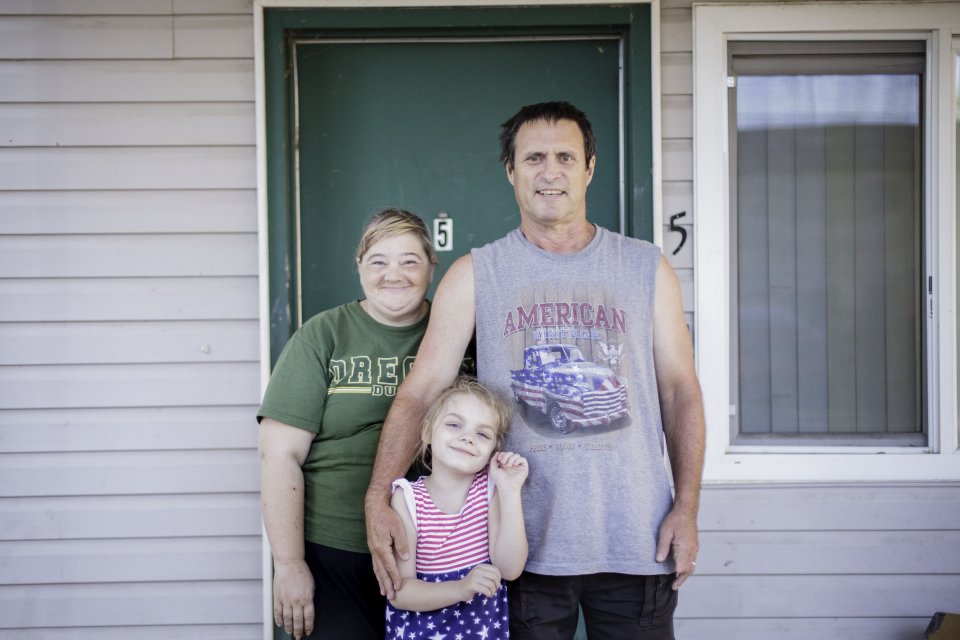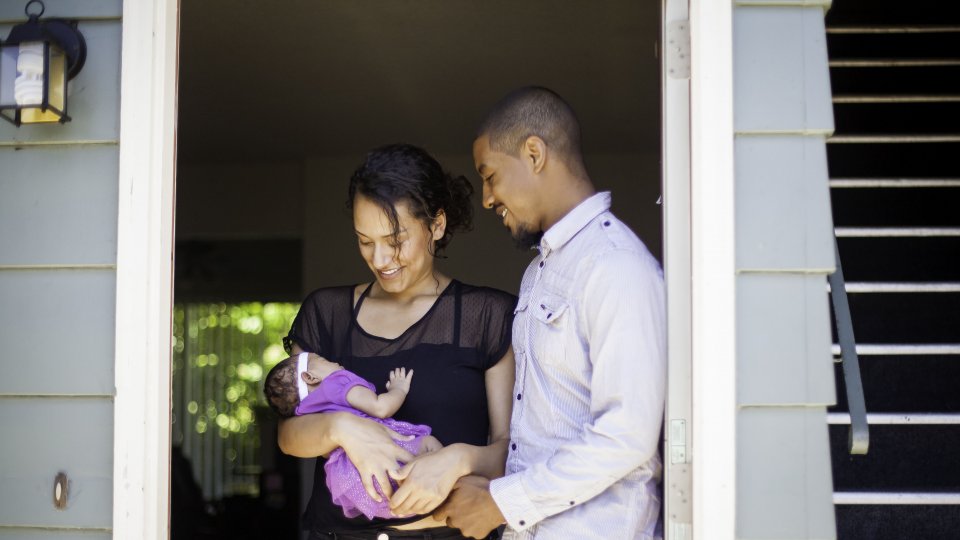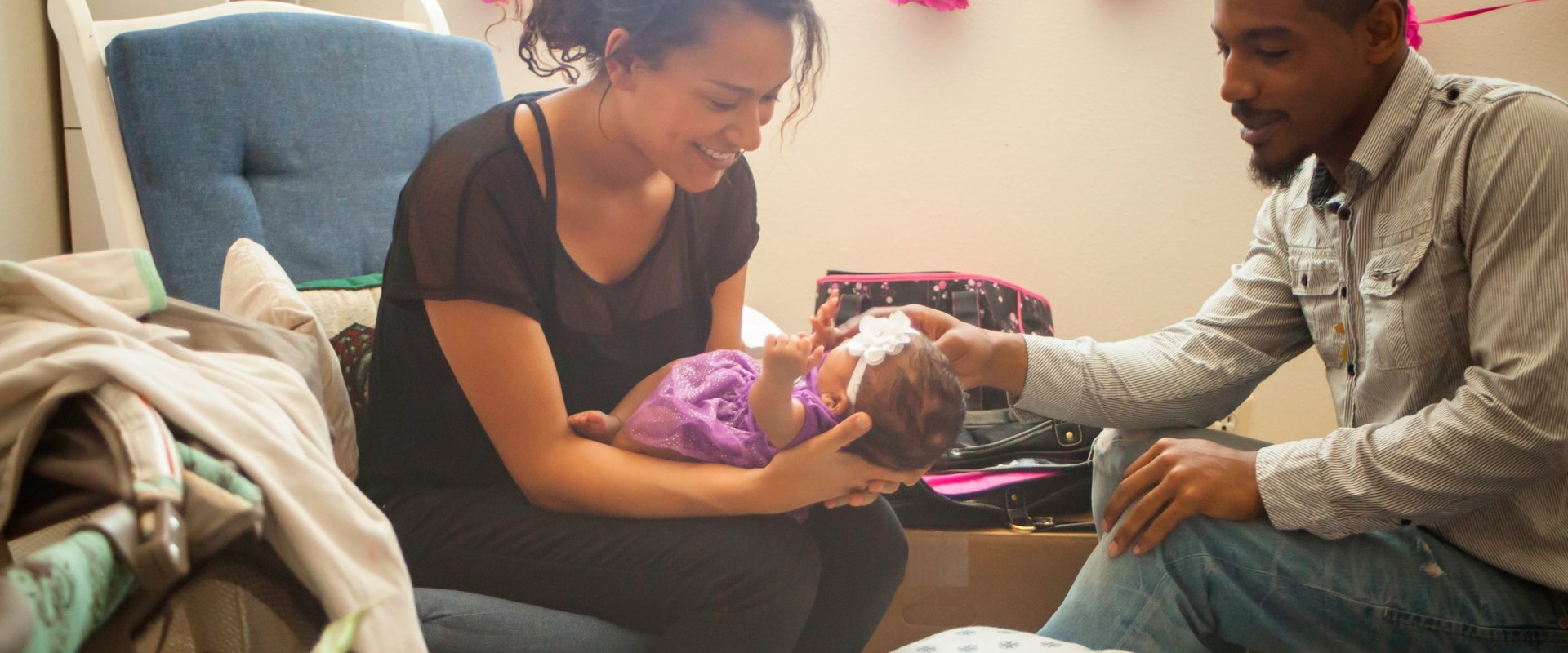Wednesday, Oct. 5, 2016
Cheery bursts of pink tissue paper flowers and treasured comic books line the walls where Marina and Nathan Brazille cradle their newborn daughter, Rose.
Just a year ago, however, those walls, this room, seemed far out of reach.
A series of unfortunate events—job loss, rent increase, car accident—forced the hard-working couple, then expecting their first child, to lose their Vancouver apartment in Washington and live in their van for more than four months.
Support from United Way partner Council for the Homeless in Clark County eventually helped Marina and Nathan secure housing and create this family home.
“I was doing everything that I could and losing hope,” remembered Nathan.
“Within two days [of visiting Council for the Homeless], I was sure that we were going to have somewhere and I was sure that we were going to make it,” he added with a grateful smile.
Rising Costs Threaten Low-Income Families Most
“It is extremely difficult to have family stability without having a safe and reliable place to live,” said Mayra Arreola, United Way’s Director of Community Collaborations and Investments. United Way is working with local organizations to create solutions to the challenges of poverty, including helping families meet their basic needs so kids can focus in school.
That’s why United Way invests in short-term rental assistance with partners like Council for the Homeless, as well as Community Action in Washington County, Home Forward in Multnomah County and Northwest Housing Alternatives in Clackamas County. Last year through rent and utilities assistance, United Way helped over 2,000 households and 6,000 individuals stay in their homes.
The need has become even greater in the past few years as unprecedented difficulty finding housing—and the higher likelihood of losing housing—is fueled by increased rental demand, low vacancies and rising rents across our region.
“I would definitely describe it as a crisis,” said Andy Silver, Executive Director of the Council for the Homeless. “In the last five years in our area, income has gone up an average of three percent while rent has gone up 38%.”
More people moving to this area, combined with the highest percentage of renters nationally since the 1960s, leaves few vacancies for which landlords can charge a premium.
Rent hikes in the hundreds each month force people, like Nathan and Marina, out of their previously affordable homes. Astronomical move-in costs make it difficult for families trying to transition out of homelessness or find more affordable places to live.
“People who are the most vulnerable—on a fixed income, or with disabilities, for example—are taking the brunt of this,” said Silver.
Low-income families who must now put as much as half of their resources toward rent have much less of a safety net if something unexpected happens. Housing experts generally indicate that households that spend more than 30% of their income on housing per month, have to make tradeoffs with other important expenses like healthcare, utilities, food and emergencies.
Emergency rent assistance from United Way and partners can act as that safety net and prevent the trauma and cost of becoming homeless for people like Holly and Jim Morris and their 15-year-old son, Tyler.
The family nearly lost their apartment in Forest Grove when their rent money order was lost in the mail and they couldn’t find the receipt. On a fixed income because of disabilities, they couldn’t afford to re-pay the rent twice.
Community Action provided $500 toward their rent when they received the eviction notice.
“Not only did they pay our rent, but they paid our electric bill!” Holly added with appreciation, referring to the energy assistance Community Action also provides to low-income families.
Hidden Homelessness and Consequences for Children

Keeping their home was especially critical because Holly’s oldest son, his girlfriend and their five-year-old daughter, Maddison, are also staying there until they can afford to pay the move-in costs for their own apartment.
This “doubling up” is a common sign of the housing crisis in suburbs, noted Jessi Adams, who manages Community Action’s energy and emergency rent assistance program.
“In the suburbs, [the crisis] is much more hidden. People don’t necessarily meet the definition of homeless—they’re not sleeping on the streets—but they’re in very precarious situations because they’re depending on friends and family to house them and that situation can change daily.”
These precarious realities breed stress that trickles down from parents to children and can have long-lasting consequences.
Uncertainty from switching schools, losing friends and not knowing where you will sleep each night prevents children from focusing on learning.
“The amount of times kids jump around in school because they’re moving from affordable housing to affordable housing or from [staying with a] family member to a friend…that has a huge impact on their education,” explained Adams.
“They’re going to fall behind in reading and basic skills and that just kind of snowballs into them being less likely to graduate high school if they’re bouncing around in elementary school,” she added.
When Marina and Nathan Brazille found out they were having a baby, these potential future consequences made their search for housing even more urgent.
Money is Not the Only Barrier
It turns out that economics are not even the most difficult and disproportionate housing barrier anymore.
“Just as damaging, we’ve seen screening criteria get tighter,” said Silver. “When you have more demand than supply, landlords can be more choosy about who they rent to.”
Adams pointed out, “If you are a low-income household…you may have a spotty rental history, or you’ll have a 72-hour notice in the past. All these things build up to make you less attractive to a new landlord.”
The Brazilles had been forced to break their lease when the rent was raised out of their range and found out that there are fewer, if any, second chances these days.
After months of paying application fees and “being denied because we broke a lease, it’s hard to get back on your feet and you’re constantly spending the money that you have saved,” Nathan spoke softy. “We were just lost and kind of stuck.”
Both Silver and Adams emphasize relationship-building as a necessary strategy to help families stuck in this web of housing barriers.
The Council for the Homeless not only covered all of Marina and Nathan’s move-in costs, but also provided housing navigation by talking with the landlord to explain the circumstances and their potential for success in maintaining housing on their own.
And just in time, because a car accident left Nathan with herniated discs that required a restful place to recuperate and medical costs that added strain on their finances.
“It was amazing, it was like winning the lottery!” Marina said, her gentle grin lighting up her face at the memory of getting approved for the apartment. “It means a lot to have a home that is safe and is yours. We worked hard that first month and we were good ever since then.”
Both Council for the Homeless and Community Action continue to have conversations with landlords to create partnerships where “they are willing to take a chance if we are willing to throw our support behind a household,” explained Adams.
Collaboration Improves Services and Addresses Disparities
Both organizations are also having conversations with each other—and various organizations working on housing and homelessness—which United Way brought together to build a stronger network and promote innovation.
Flexible-funding support from United Way helps these local partners improve services to reach more children and families. Sharing best practices and resources closes gaps and creates a stronger system for our entire region.
In a time of such urgent need, this alignment is critical to disrupting the effect of childhood poverty from every angle, “so there arises stronger ways of serving the community,” said United Way’s Mayra Arreola.
‘It has affirmed our belief that many of our clients can benefit from more than one program,” said Community Action’s Director of Advancement Kemp Shuey. So they’re ensuring their services are better coordinated to make sure people, no matter why they initially call or visit for help, “are getting connected with additional resources they may need.”
Andy Silver has found the United Way network a great place to identify more effective responses to specific housing barriers that are acutely experienced by communities of color.
As the Vancouver community becomes more diverse, racial disparities have become more pronounced in an increasingly competitive housing market—especially the use of criminal history as screening criteria in a society where people of color are disproportionately arrested and incarcerated—and has connected with Portland Community Reinvestment Initiatives’ work on this.
“We didn’t have these sorts of conversations or opportunities before,” he noted. Council for the Homeless has been able to incorporate some of the solutions from PCRI directly into their work.
Determined to Create a More Stable Future for Children

Helping the most vulnerable families struggling through the housing crisis means we can’t work in isolation. Forging new collaborations also allows organizations to reach families where they’re at.
Many times, the first place that the impact of a housing crisis appears is in children’s absences from school. So Council for the Homeless is working with school districts across Clark County to put housing coordinators in schools to help families before they are forced to move or become homeless—rather than waiting for them to find and navigate housing assistance that can be confusing when a family is already in crisis.
“You also have the turmoil in the classroom when there’s as much as 50% turnover in the course of a year. It’s obviously difficult for the children who are moving and it’s also difficult for the children who are left behind,” explained Silver. “It is a community-wide problem.”
It’s work that aims to prevent the crisis of homelessness and support children’s success in school. The goal is lasting transformation and a more stable community for all families well into the future.
Meanwhile, Marina and Nathan have a new hope for their future. Since bringing baby Rose home in late June they are determined to maintain and build on this stability to create a lasting family legacy.
“We want to eventually get some land and have a house, be out in the country, grow our own food,” Marina described.
“You have the land, it’s yours…it’s something there, and when me and her are gone, Rose will have something that’s always hers,” added Nathan. “Aim for something to hold on to, something nobody can take from you.”
There are still struggles with Nathan’s recovery and medical bills until he can return to work. But even more than money, feeling the connection with Council for the Homeless staff and their belief in Nathan and Marina to overcome crisis has propelled the resilient, kind couple forward.
With the current precarious housing realities, it’s clear that we may all need a helping hand once in awhile. Ensuring a bright future for children like Rose means believing in families like the Brazilles to build on short-term assistance.
It means believing in our partners’ work to help turn despair into dreams like these. And it means believing in the possibility to transform our communities into places everyone can call home.
Our work together is more important than ever to ensure that every family in our region has a safe place to sleep at night.
See how your local United Way is helping families meet basic needs so kids can focus in school – click here for our 2016 digital report.
For more information on affordable housing efforts in our region, check out Bring Vancouver Home in Clark County and Yes for Affordable Homes in Multnomah County.


